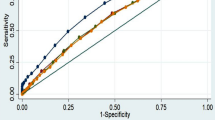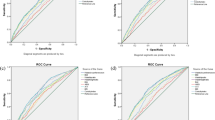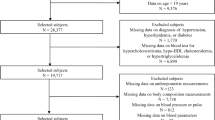Abstract
Objective:
To examine the relationship of body mass index (BMI), waist circumference (WC), waist-to-hip ratio (WHpR) and waist-to-height ratio (WHtR) with cardiovascular risk factors and diabetes in Thai population.
Design:
A national cross-sectional survey of cardiovascular risk factors.
Subjects:
Five thousand and three hundred five Thai adults aged ⩾35 years.
Measurements:
Body weight, height, waist and hip circumference and cardiovascular risk factors including blood pressure, total plasma cholesterol, high-density lipoprotein, triglyceride and fasting plasma glucose were measured. Age- and sex–specific means and prevalence of cardiovascular risk factors were calculated and compared among anthropometric measurements.
Results:
There were increasing trends of severity of cardiovascular risk factors and prevalence of morbidity conditions across increasing levels of BMI, WC, WHpR and WHtR categories. For age group ⩾65 years, WC, WHpR and WHtR provided more consistent association with cardiovascular risk factors than BMI. Area under the curve indicated that measurement of central obesity could predict cardiovascular risk better than BMI. The optimal cutoff points for anthropometric measurements were in line with the Asia-Pacific recommendation; however, similar cutoff point for men and women between 82 and 85 cm was observed.
Conclusion:
Central obesity indices were slightly better associated with cardiovascular risk factors compared to BMI in Thai adults aged ⩾35 years.
This is a preview of subscription content, access via your institution
Access options
Subscribe to this journal
Receive 12 print issues and online access
$259.00 per year
only $21.58 per issue
Buy this article
- Purchase on Springer Link
- Instant access to full article PDF
Prices may be subject to local taxes which are calculated during checkout
Similar content being viewed by others
References
WHO. Obesity: preventing and managing the global epidemic Report on a WHO consultation on Obesity, Geneva, 3–5 June, 1997, WHO/NUT/NCD/98.1. Technical Report Series Number 894 Geneva: World Health Organization, 2000.
Han TS, Richmond P, Avenell A, Lean MEJ . Waist circumference reduction and cardiovascular benefits during weight loss in women. Int J Obes Relat Metab Disord 1997; 21: 127–134.
Woo J, Ho SC, Yu ALM, Sham A . Is waist circumference a useful measure in predicting health outcomes in the elderly? Int J Obes Relat Metab Disord 2002; 26: 1349–1355.
Zhu S, Wang Z, Heshka S, Heo M, Faith MS, Heymsfield SB . Waist circumference and obesity-associated risk factors among whites in the third National Health and Nutrition Examination Survey: clinical action thresholds. Am J Clin Nutr 2002; 76: 743–749.
Janssen I, Katzmarzyk PT, Ross R . Waist circumference and not body mass index explains obesity-related health risk. Am J Clin Nutr 2004; 79: 379–384.
WHO Expert Consultation. Appropriate body-mass index for Asian populations and its implications for policy and intervention strategies. Lancet 2004; 363: 157–163.
Alberti KGMM, Zimmet P, Shaw J, for the IDF Epidemiology Task Force Consensus Group. The metabolic syndrome – a new worldwide definition. Lancet 2005; 366: 1059–1061.
Hsieh SD, Yoshinaga H . Abdominal fat distribution and coronary heart disease risk factor in men – waist/height ratio as a simple and useful predictor. Int Obes Relat Metab Disord 1995; 19: 585–589.
Deurenberg P, Deurenberg-Yap M, Guricci S . Asians are different from Caucasians and from each other in their body mass index/body fat per cent relationship. Obes Rev 2002; 3: 141–146.
Deurenberg P, Deurenberg-Yap M . Validity of body composition methods across ethnic population groups. In: Modern Aspects of Nutrition: Present Knowledge and Future Perspectives. Forum Nutr Basel Karger 2003; 56: 299–301.
Stolk RP, Suriyawongpaisal P, Aekplakorn W, Woodward M, Neal B . Fat distribution is strongly associated with plasma glucose levels and diabetes in Thai Adults-the InterASIA study. Diabetologia 2005; 48: 657–660.
The InterASIA Collaborative Group. Cardiovascular risk factor levels in urban and rural Thailand – The International Collaborative Study of Cardiovascular Disease in ASIA (InterASIA). Cardiovasc Prevent Rehab 2003; 10: 249–257.
Myers G, Cooper G, Winn C, Smith S . The Center for Disease Control – National Heart, Lung, and Blood Institute Lipid Standardization Program. Clin Lab Med 1989; 9: 105–135.
Aekplakorn W, Chaiyapong Y, Neal B, Chariyalertsak S, Kunanusont C, Phoolcharoen W et al. Prevalence and determinants of overweight and obesity in Thai adults: results of the Second National Health Examination Survey. J Med Assoc Thai 2004; 87: 685–693.
Lee ZSK, Critchley JAJH, Ko GTC, Anderson PJ, Thomas GN, Young RP et al. Obesity and cardiovascular risk factors in Hong Kong Chinese. Obes Rev 2002; 3: 173–182.
Zhou BF, the Cooperative Meta-analysis group of working group on obesity in China. Predictive values of body mass index and waist circumference for risk factors of certain related diseases in Chinese adults: study on optimal cut-off points of body mass index and waist circumference in Chinese adults Asia Pacific. J Clin Nutr 2002; 11 (suppl): s685–s693.
Tan CE, Emmanuel SC, Tan BY, Jacob E . Prevalence of diabetes and ethnic differences in cardiovascular risk factors. Diabetes Care 1999; 22: 241–247.
Ko GTC, Chan JCN, Cockram CS, Woo J . Prediction of hypertension, diabetes, dyslipidemia or albuminuria using simple anthropometric indexes in Hong Kong Chinese. Int J Obes Relat Metab Disord 1999; 23: 1136–1142.
Zhou B, Wu Y, Yang J, Li Y, Zhang H, Zhao L . Overweight is an independent risk factor for cardiovascular disease in Chinese populations. Obes Rev 2002; 3: 147–156.
Huang KC, Lin WY, Lee LT, Chen CY, Lo H, Hsia HH et al. Four anthropometric indices and cardiovascular risk factors in Taiwan. Int J Obes Relat Metab Disord 2002; 26: 1060–1068.
Gostynski M, Gutzwiller F, Kuulasmaa K, Doring A, Ferrario M, Grafnetter D, et al., for the WHO MONICA Project. Analysis of the relationship between total cholesterol, age, body mass index among males and females in the WHO MONICA Project. Int J Obes Relat Metab Disord 2004; 28: 1082–1090.
Turcato E, Bosello O, Francesco VD, Harris TB, Zoico E, Bissoli L et al. Waist circumference and abdominal sagittal diameter as surrogates of body fat distribution in the elderly: their relation with cardiovascular risk factors. Int J Obes Relat Metab Disord 2000; 24: 1005–1010.
Li G, Chen X, Jang Y, Wang J, Xing X, Yang W et al. Obesity, coronary heart disease risk factors and diabetes in Chinese: an approach to the criteria of obesity in the Chinese population. Obes Rev 2002; 3: 167–172.
Lin WY, Lee LT, Chen CY, Lo H, Hsia HH, Liu IL et al. Optimal cut-off values for obesity: using simple anthropometric indices to predict cardiovascular risk factors in Taiwan. Int J Obes Relat Metab Disord 2002; 26: 1232–1238.
Misra A, Wasir JS, Vikram NK . Waist circumference criteria for diagnosis of abdominal obesity are not applicable uniformly to all populations and ethnic groups. Nutrition 2005; 21: 969–976.
Pouliot MC, Despres JP, Lemieux S, Moorjani S, Bouchard C, Tremblay A et al. Waist circumference and abdominal sagittal diameter: the best simple anthropometric indices of abdominal visceral adipose tissue accumulation and related cardiovascular risk in men and women. Am J Cardiol 1994; 73: 460–468.
Dobbelsteyn CJ, Joffres MR, MacLean DR, Flowerdew G . A comparative evaluation of waist circumference, waist-to-hip ratio and body mass index as indicators of cardiovascular risk factors. The Canadian Heart Health Survey. Int J Obes Relat Metab Disord 2001; 25: 652–661.
Wang Z, Hoy WE . Waist circumference, body mass index, hip circumference and waist-to-hip ratio as predictors of cardiovascular disease in Aboriginal people. Eur J Clin Nutr 2004; 58: 888–893.
Aswell M, Hseieh SD . Six reasons why the waist-to-height ratio is a rapid and effective global indicator for health risks of obesity and how its use could simplify the international public health message on obesity. Int J Food Sci Nutr 2005; 56: 303–307.
Acknowledgements
InterASIA Collaborative Group: Thailand: Mahidol University, Bangkok – Paibul Suriyawongpaisal, Sayan Cheepudomwit, Porntip Loelekla, Piyamitr Srithara; Bangkok - Poolsook Sariyaporn, Pairao Pongchoke, Somboon Jaiyavat, Charermsri Nantawan, Vachira Kasikoson; North - Somsak Thamthitiwat, Penprapa Siviroj, Jiraporn Suwanteerangkul; Northeast - Pyatat Tasanavivat, Pattapong Kessomboon, Sujinan Horas; South - Virasakdi Chongsuvivatwong, Tada Yipintsoi, Nualta Apakupakul, Walla Jirathamopas, Woravut Jintapakorn; Central - Vongsvat Kosulwat, Atitada Boonpraderm, Amornrat Wongchanapai, Chayanist Wanijjakul. Australia: Institute for International Health, University of Sydney - Neil Chapman, Sam Colman, Stephen MacMahon, Bruce Neal, Ronald Stolk, Mark Woodward. Steering Committee: Jiang He, Paul Whelton, Dale Glasser, Dongfeng Gu, Stephen MacMahon, Bruce Neal, Rajiv Patni, Robert Reynolds, Paibul Suriyawongpaisal, Xigui Wu, Xue Xin, Xin-Hua Zhang.
Financial support: The InterASIA study was funded by a contractual agreement between Tulane University, LA, USA and Pfizer, Inc., NY, USA. Two researchers employed by Pfizer, Inc. were members of the Steering Committee that designed the study. However, the study was conducted, analyzed, and interpreted by the investigators independent of the sponsor. Finally, we thank Professor Dr Amnuay Thithapandha for his kindness help in editing this manuscript.
Author information
Authors and Affiliations
Corresponding author
Rights and permissions
About this article
Cite this article
Aekplakorn, W., Kosulwat, V. & Suriyawongpaisal, P. Obesity indices and cardiovascular risk factors in Thai adults. Int J Obes 30, 1782–1790 (2006). https://doi.org/10.1038/sj.ijo.0803346
Received:
Revised:
Accepted:
Published:
Issue Date:
DOI: https://doi.org/10.1038/sj.ijo.0803346
Keywords
This article is cited by
-
Obesity and occupation in Thailand: using a Bayesian hierarchical model to obtain prevalence estimates from the National Health Examination Survey
BMC Public Health (2021)
-
Body mass index and type 2 diabetes in Thai adults: defining risk thresholds and population impacts
BMC Public Health (2017)
-
Optimal waist circumference cut-off points and ability of different metabolic syndrome criteria for predicting diabetes in Japanese men and women: Japan Epidemiology Collaboration on Occupational Health Study
BMC Public Health (2016)
-
Anthropometric parameters and their associations with cardio-metabolic risk in Chinese working population
Diabetology & Metabolic Syndrome (2015)
-
Optimal waist-to-height ratio cutoff values for predicting cardio-metabolic risk in Han and Uygur adults in northwest part of China
European Journal of Clinical Nutrition (2015)



